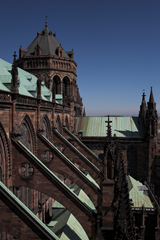Welcome back! (So it’s only been three days, but with the new semester and all…)
We began Frankenstein in a bit of a roundabout way today—with a discussion of what it means to be Gothic. While the first image that came to many of you was a pale kid in black with eyeliner ((BTW, did you know there is a Goth Day at Disneyland? Something about all that black and the CA sunshine gives me images of streaking makeup…)), we eventually came up with this:
 Flying buttresses. It’s a good start.
Flying buttresses. It’s a good start.
Basically, things (be they art, architecture, literature, or music) that fall under the “Gothic†heading are eerie, ominous, looming, grotesque, and sometimes monstrous. ((There’s a great gallery of 19th century Gothic architecture at Boston College’s website.)) Coming out of the realism and social commentary that dominated the Age of Enlightenment (think Gulliver’s Travels and “A Modest Proposalâ€), authors writing Gothic literature in the 19th century turned away from such practical views of the world and focused on settings and the emotional experience of events.
This is exemplified perfectly by Schubert’s Erlkönig (1815) ((You can thank your band teacher for this connection)), a piece based on Goethe’s poem (1782) of the same name, which in turn was based on a creature from Danish folktales. ((I found this information, along with an English translation, on the wiki page.)) The Leid tells the story of a boy and his father traveling through deep dark woods, with the son becoming more and more frightened by a supernatural presence. Of course, the father doesn’t seem worried, and by the end of the journey, he finds he’s carrying a dead child. Emotional, terrifying, grotesque, sublime: Gothic.
Architecture, art, and music at the time emphasized these emotions and attempted to elicit feelings of awe and the sublime in their audiences. (Remember our awe discussions with the Existentialists and Rosencrantz and Guildenstern are Dead?)
As you read Frankenstein, keep this in mind. Shelley was certainly commenting on the effects of the Industrial Revolution (a solid insight by a few of you). But more than anything, she elicits a feeling of the sublime and grotesque in her audience.
Things to Journal:
- Scary, beautiful, sublime, etc. scenes
- Connections with the Prometheus myth
- Connections with Milton’s Paradise Lost (we’ll be looking at that in class tomorrow)
- Questions (and answers as you come up with them). Here’s a few to get you started:
- How does the author view her work?
- Why do you think she wrote it, after reading her foreword?
- Why did she hide her authorship the first time around?
Before Class Tomorrow:
Read everything within and around the book (cover, title page, notes at the back, and foreword) that isn’t the story itself. Journal as you have with previous works. (See “Things to Journal†above if you need a kick-start.)
